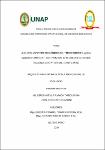Algunos aspectos ecológicos del "mono choro" Lagothrix lagotricha Humboldt, 1812 (primates: Atelidae) en el Parque Nacional Güeppí-Sekime, Loreto-Perú

View/
Date
2019Author
Rimachi Taricuarima, Milagros Natalia
Perez Gardini, Juan Jesús
Metadata
Show full item recordAbstract
El estudio se realizó en el Parque Nacional Güeppí Sekime, departamento de Loreto-Perú, entre los meses de junio y setiembre del 2017. El propósito fue conocer algunos aspectos ecológicos de Lagothrix lagotricha lagotricha; los datos se obtuvieron mediante las técnicas etológicas del Scan Sampling o rastreo de grupo y el Behaviour Sampling.
L. l. lagotricha utilizó un área domiciliar de 140,42 hectáreas; las actividades de comportamiento se realizaron en tres estratos verticales del bosque, donde el estrato medio fue el más utilizado. La locomoción, la alimentación y el descanso estuvieron más relacionados al estrato medio y superior. El grupo consumió 98 especies de plantas, donde destacaron las familias Moraceae, Fabaceae y Araceae, junto a los géneros Ficus, Philodendron, Parkia y Pouteria. Su dieta específica consistió en 20 ítems alimenticios, destacando las hojas y frutos completos. La especie se interrelacionó con 4 especies de aves y 5 de primates; entre las aves la más importante fue Ara macao como competidor y entre los primates el más importante fue Leontocebus nigricollis, con esta especie tuvo una relación de cooperación y competencia. En base al tipo de bosque utilizado y la diversidad de especies de plantas consumidas se concluye que esta especie de primate puede considerarse indicador de un ecosistema en buen estado. The study was carried out in the National Park Güeppí-Sekime, department of Loreto-Peru, between the months of June and September of the 2017. The purpose was to know some ecological aspects of Lagothrix lagotricha lagotricha; the data were obtained by means of the ethologies technical of the Scan Sampling or rake of group and the Behaviour Sampling.
L. l. lagotricha used a home range of 140,42 hectares; the behavior activities were carried out in three vertical strata of the forest, where the half stratum was the most used one. The locomotion, the feeding and the rest were more related to the half stratum and superior. The group consumed 98 species of plants, where they highlighted the families Moraceae, Fabaceae and Araceae, next to the goods Ficus, Philodendron, Parkia and Pouteria. Their specific diet consisted on 20 nutritious articles, highlighting the leaves and complete fruits. The species was interrelated with 4 species of birds and 5 of primates; among the birds the most important was Ara macao like competitor and among the primates the most important was Leontocebus nigricollis, with this species had a cooperation and competition relationship. Based on the type of used forest and the diversity of species of consumed plants you concludes that this primate species can be considered indicator of an ecosystem in good state.
Collections
- Tesis [418]
The following license files are associated with this item:

